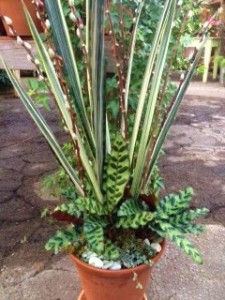Some pictures from the greenhouse in winter…Rex begonias, agloenemas (Chinese evergreens), angel wing begonias, fronds of a neantha bella palm, variegated Algerian ivy, Sanseveria, plumosa ferns, aloe and succulents. Can you find them all?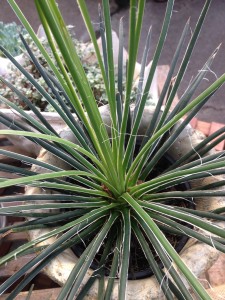
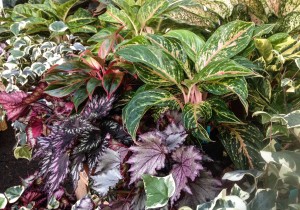
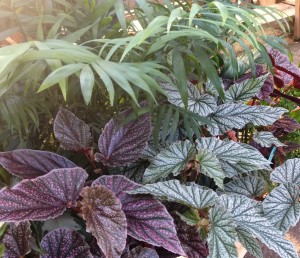
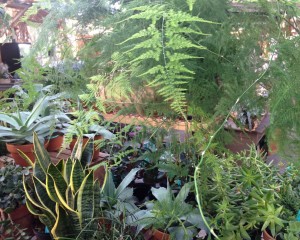
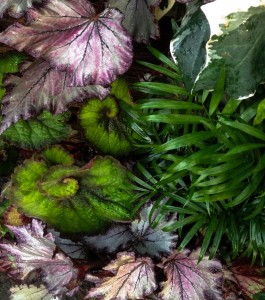
Category Archives: House Plants
Tiny Plants…Great For Terrariums Or Small Containers Too!
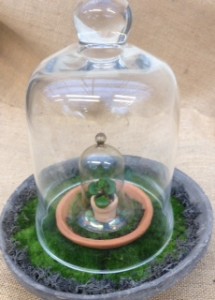 If you haven’t noticed, terrarium plantings, miniature gardens and anything tiny seems to be the name of the game the past few years. Growers have taken notice and now offer a wonderful variety of plants for the smallest of indoor gardening opportunities.
If you haven’t noticed, terrarium plantings, miniature gardens and anything tiny seems to be the name of the game the past few years. Growers have taken notice and now offer a wonderful variety of plants for the smallest of indoor gardening opportunities.

fittonia
Very little two-inch pots are just the right size for these starter plants. Some are quite easy to grow houseplants that are usually available in larger containers, and others are small succulents. Because of their diminutive size, it’s quite easy to incorporate them into mixed terrarium plantings or miniature gardens.

An assortment of
tiny houseplants…

Small ferns are
perfect for
terrariums….

Rex begonias appreciate
the humidity in a
terrarium….
For terrarium plantings, choose from many easy to grow moisture loving plants. These include ferns, fittonia, Rex begonia, aluminum plant, pilea, strawberry begonia (It’s a good perennial groundcover in the shade too!), creeping fig, and others that enjoy high humidity in an enclosed environment.

Hoya…
Small succulents and other houseplants, like jades and hoyas, are best used in open containers and miniature gardens. They offer a wide range of colors, shapes and textures and are quite easy to take care of too. The hoya pictured here in the open glass container has been growing for months, quite happily!
January In The Greenhouse…

air plants have found a home in these colorful frames…
January in the greenhouse is a quiet time. Sure, there are folks coming in for a houseplant for a pot, or to pick up a few pansies to fill in their winter weary containers, but for the most part there’s plenty of time to work on projects of all sorts.
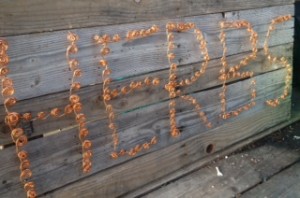
Molly created this herb sign with aluminum wire and old pallets…
This month, Jamie, Pinkie and Molly, with the help of Lauren, have been painting up a storm, and the stage area has taken on a new look. Molly is also working on signs for the outdoor nursery, while Bert and Ben are building new tables. it’s fun to change things up, and this is the time of year to do it!
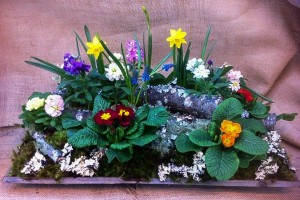
a spring garden using lichen covered branches and spring flowers…
Of course, arrangements take priority always, for customers who come in needing something for themselves, for a party or to give as a gift – and we enjoy this creative outlet too. Jamie brought in a lot of lichen covered branches, and has been using them beautifully as part of table top arrangements. They look wonderful mixed in with the bright primroses of winter, and the forced bulbs including narcissus, muscari, and soon, tulips and crocus.
Winter branches of pussy willow have been a staple too, and we’ve been adding them to orchid and foliage arrangements. Soon the greenhouse will be filled with even more houseplants of all sorts, and we’ll begin creating combinations of plantings that can be transferred outside when the temperatures warm, later in the spring.
January in the greenhouse is spent doing chores that must be done, but also on things that are just plain fun!
Flowers And More For The Holidays…
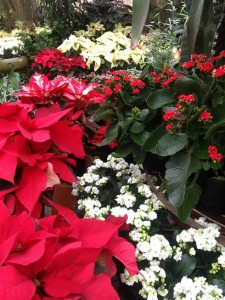 The greenhouse is so beautiful all year round, but it’s especially so in the height of the holiday season. In fact, sometimes there are so many flowers and new plants coming in almost daily that they are literally everywhere – on tables, on the floor around tables, and anywhere we can find a spare space. Never let it be said we don’t have a little something for everyone!
The greenhouse is so beautiful all year round, but it’s especially so in the height of the holiday season. In fact, sometimes there are so many flowers and new plants coming in almost daily that they are literally everywhere – on tables, on the floor around tables, and anywhere we can find a spare space. Never let it be said we don’t have a little something for everyone!
Start with the bulbs of the season…paperwhites for fragrance and amaryllis for elegance. Paperwhite bulbs are readily available and so easy to plant in potting soil or a pretty bowl with pea gravel and water. We’ll also have plenty each week from growers, already planted, up and ready to bloom.
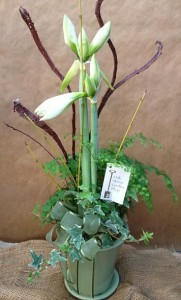
An elegant amaryllis is a wonder gift…
Amaryllis bulbs are notoriously tricky to time; they will come up when they’re good and ready, thank you very much! If you want an amaryllis for a certain date, it’s really best to buy them a week ahead already budded.
Many years ago I promised a customer that, of course, I could have 12 amaryllis, all in full bloom, on a certain date for a big party…oh, did I sweat those! I thought I had all my ducks in a row until the date I received them from the grower. They were beautiful, with tall strong stems and large….buds. (They had done their best to get them to the right stage of bud/bloom.)
The party was in less than a week, so I put them in the warmest spot in the greenhouse and worked some juju to make them bloom. Thankfully, they cooperated, and my customer didn’t know how close she came to having beautiful amaryllis….in bud. (Wait a minute, who am I kidding? I would have been scouring the city for 12 amaryllis in bloom!)
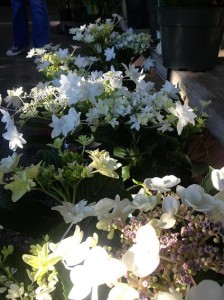
A ‘Shooting Star’ hydrangea…
In the last five years or so, hydrangeas have become a popular holiday flower. Growers force these into bloom for the season, and they really are spectacular on their own, in an arrangement for a party, or to give as a gift. If I would tell anyone the one thing to remember when they receive or purchase a hydrangea for themselves, it is this – please keep them watered. If they’re allowed to dry out one too many times, there will be brown spots on the otherwise beautiful blooms.
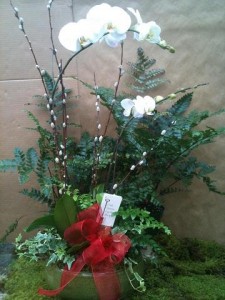
Phaelenopsis orchid…
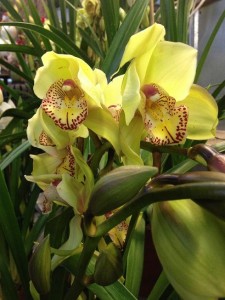
Regal cymbidium orchids make quite a statement…
We have orchids every month of the year, but their beauty is particularly enticing through the holidays. They add a touch of elegance to any setting, beginning with the most common and easy to grow phaelenopsis, or moth orchid. Through December we also carry the impressive cymbidium orchids, with their fans of leaves and huge, drooping buds and blooms in shades of pink, yellow and white. Or you may want to try a diminutive but long lasting lady slipper orchid, whose leaves are often as beautiful as the blooms.
And the list goes on…with the sturdy and bright rieger begonias, the trick to growing them well is to give them plenty of light and go easy on the water. Be diligent in pulling off old fading blooms, and they will reward you with many weeks of color!

Pretty cyclamen…
Cyclamen are another wonderful winter bloomer, flourishing in cool temperatures and going dormant as temperatures warm in the spring. Be very careful not to overwater (It’s best to water these from the bottom.) and keep them in as cool a spot as you can.
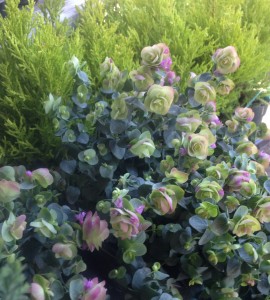
Ornamental oregano and lemon cypress…
These are just a few of the beautiful plants gracing the greenhouse throughout the holidays, Many others are grown more for foliage or scent, such as ornamental oregano, golden lemon cypress, myrtle, and, of course the poinsettia, a mainstay of the season. There’s simply nothing prettier than a greenhouse in full bloom!
Living Wreaths – Here’s How! (The original vertical garden…)
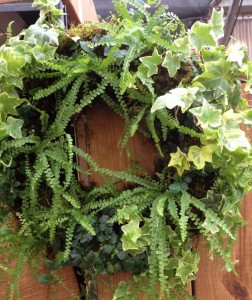
A living wreath planted for shade using houseplant ferns, creeping fig and ivy…
This post is for all you do-it-yourselfers and those that just like to know how interesting plantings are created. Living wreaths are one of those things, or, as I like to think of them, the original vertical garden arrangement. Maybe you’ve seen them on Pinterest or at your favorite garden shop (Of course, if you’re in Birmingham, we hope that’s us!).
Living wreaths are not difficult to make and are really quite fun – it just takes some time and a little thought choosing plants. The first step is deciding where you’d like to have your living wreath. Perhaps you have a gate leading into your garden? Or maybe there’s a blank spot on that shady patio wall? They also work well placed on a flat surface such as a table.
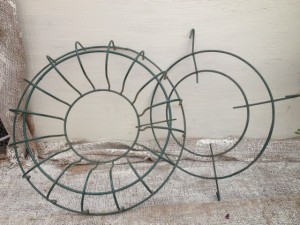
The sturdy wreath form you see here is a standard plastic coated 16″ size. You can see there are two pieces, and the smaller back piece hooks easily onto the larger one.
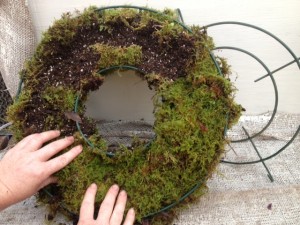
Lining the form prior to planting…
Many how-tos for living wreaths use moistened sphagnum moss to line the form. We plant them a bit differently, lining the form with moistened green sheet moss, then filling the cavity with potting soil and slow release fertilizer before planting. We’ve been planting hayracks, moss baskets and wreaths like this for over 20 years in this manner.
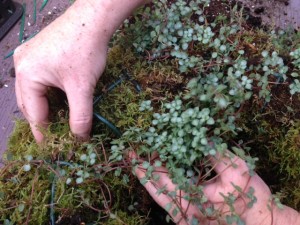
insert plants at intervals through the moss, firming in.
Jamie designed the wreath in this demonstration for a customer who wanted an interesting mix of foliage for use in a bright location. Her plant material includes pilea, tillandsias, tiny pink cryptanthus, and baby tears. It’s important to understand the cultural needs of the plants being used so any special watering needs can be met. In this composition, the baby tears will need special attention as they require the most water.
As with any open wired container that is being lined, don’t skimp on the moss. It’s the glue that’s holding everything together after all. When the form is thickly lined, add the potting soil, moistening it and firming it in, then add a slow release fertilizer like Osmocote. Remember to always use a good quality soilless mix when planting any type of container. After the cavity is filled, add more sheet moss to the “back” of the wreath and attach the smaller piece. Now your wreath form is ready to plant!
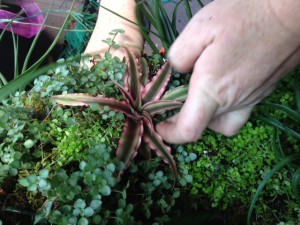
Adding the cryptanthus…
Water your plants well, then insert them into the wreath by pushing a hole into the moss with your fingers so the soilless mix is exposed. Of course, the smaller the plant the easier this step will be. Once the plant is firmed into place add more sheet moss if needed to keep the soil around the root ball of the plant.
Some plants can be purchased in larger pots and pulled apart, like the pilea and baby tears shown here. It may look a little messy at first, but they will recover in no time. Many plants that work well in living wreaths can be separated in this manner, including ivy, creeping fig, fittonia, asparagus fern, creeping jenny, dwarf mondo, some small ferns and many succulents.
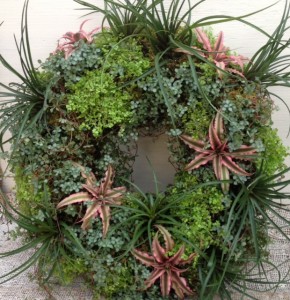
Finished!
What makes these wreaths so interesting and fun to make is the use of different foliage colors, textures and shapes. But, in addition to foliage, wreaths like those shown here can also be planted with bedding plants – in the spring begonias work well and, in the fall, violas and pansys make lovely wreaths too.
Watering requirements will vary on living wreaths, depending on the plants used. For instance, a wreath planted with succulents will need less attention than those shown here.

a living wreath for shade with fittonia, creeping fig and pilea
We’ve found the easiest watering method is to lay them flat and either pour water on them or let them sit in a saucer of water until the planting is heavy. The ivy, fern and creeping fig wreath shown at the beginning of this post lived in the greenhouse, so we were able to shower it with the hose when it needed watering, and the ivy and creeping fig was periodically pinned to the wreath with florist wire so it could root into the moss.
So, as you can see, it just takes time, the proper plants and the right technique to make a living wreath – try one for yourself!
Eye Candy and Inspiration…Container Gardens and Arrangements
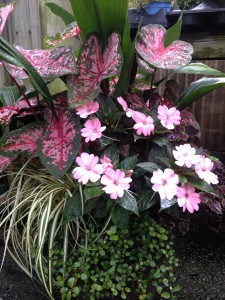
growing out nicely…
It’s summer, the heat is on, and we’re all working overtime to keep our landscapes looking as fresh as they did in the spring…thankfully we’ve been getting rainfall to help us out!
I thought you might enjoy seeing some of the planters and arrangements we’ve done through the spring and now into summer – some are succulent designs, some will enjoy the hottest part of a landscape, others are meant to stay inside or in a shady spot outside. And there are some just for a party or gift – but since they’re created with live plants they’ll last so much longer than cut flowers!
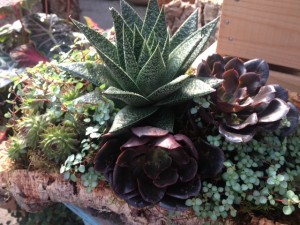
a gift for someone…
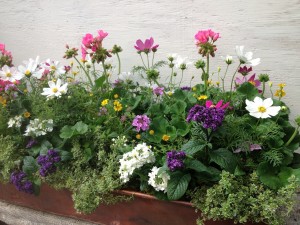
early spring…a centerpiece for a party….
Arrangements for parties or gifts using orchids, indoor flowering plants, and any other plant that catches our eye are a lot of fun to put together, and we stay very busy creating them for folks…there really is no end to the combinations that can be used for this type of arrangement. And, once the party is over, the whole thing can be taken apart and the plants used elsewhere! The copper planter shown here was used for a party – and we’re assuming the flowers and herbs were planted in a sunny garden or container and are probably still going strong!
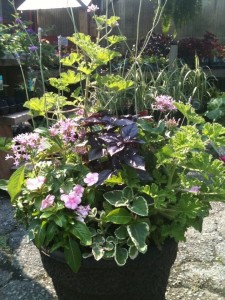
deadheading, judicious clipping and consistent watering kept this planter beautiful all last summer…
For long term plantings, smart plant choices need to be made, taking into consideration pot size and amount of light they’ll receive, Last, but definitely not least, the plants need to look good together! One of the most important aspects of container gardening is maintenance. Watering, deadheading, pinching, or, even more drastic, cutting back need to be done consistently to keep your container gardens looking their best.
The planter at left is filled with herbs and flowers designed to handle a lot of heat and sun – just what we have in the middle of summer in Birmingham! This combination grew out quite happily last summer in the front of the shop on the hot asphalt…and inspired many other planters just like it throughout town. Herbs and flowers just go together!
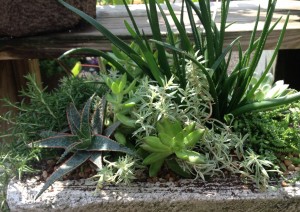
aloes, succulents and a trailing rosemary…
Succulents and herbs work quite well together…the trough planter shown here combines succulents, a couple of different aloe plants, and a trailing rosemary. Whoever said you can’t mix it up wasn’t talking to us!
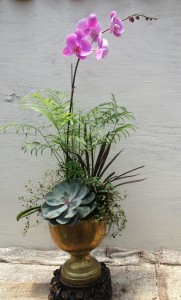
succulent and orchid arrangement…
The succulents that have been available this spring and summer have really been beautiful, and we’ve been using them in all kinds of containers, on their own in long term plantings, and in gift arrangements too. Here’s one used in an orchid arrangement as an accent…they’re quite striking used in this fashion. If you’ve been keeping up with our posts on cork bark planters , you’ve seen us use the succulents in them as well.
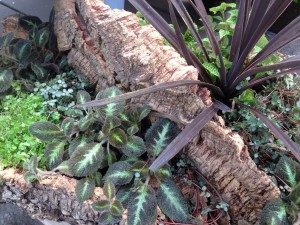
houseplants in cork bark…
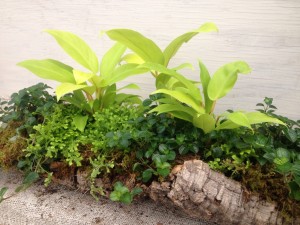
more house plants in cork bark – this one ended up on a mantle…
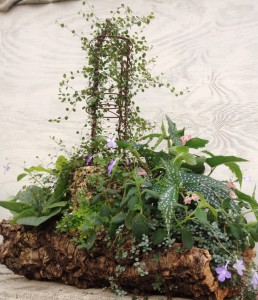
this cork bark piece was large…
Speaking of cork bark planters, here are a few pictures of some interesting things we’ve done with them…succulents aren’t the only player in this fun sandbox! A cork bark planting done using carex, ajuga, selaginella and perennial ferns ended up at a mountain home in Highlands, North Carolina. The other planting in that post also went home with a happy customer.
The ones shown above utilize a lot of houseplants and will be happiest either on a shady terrace or porch or inside in bright light. Some of the plants used include episcias, pilea, angelvine, creeping charlie, dracaena, selaginella and philodendron…all good houseplants. These will work nicely in a shady spot and there are other planters we’ve done that will too. Let’s take a look…
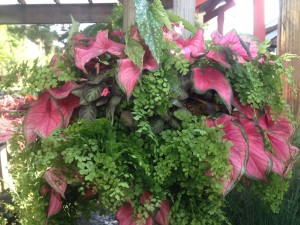
for shade…
Shade containers are some of the most fun plantings to do because so much depends on foliage color and form. This might not be as flashy as an entire pot of flowers, but it is very long lasting and beautiful when done well. The hayrack shown here uses maidenhair fern, caladiums, an angelwing begonia and episcias in a very pleasing combination…the ‘Sweetheart’ caladiums seem to float above the maidenhair, and the episcia is a very subtle addition to the composition…
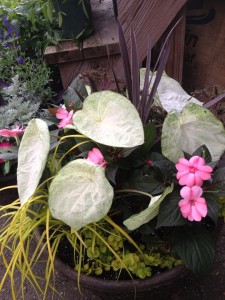 The last planting is shown to serve as an example of how you can definitely have color in the shade using foliage in addition to flowers…the ‘Garden White’ caladium in contrast with the golden carex and sunpatien really catches the eye! The planter at the top of this post is also one for shade, and, once again, the foliage is the star.
The last planting is shown to serve as an example of how you can definitely have color in the shade using foliage in addition to flowers…the ‘Garden White’ caladium in contrast with the golden carex and sunpatien really catches the eye! The planter at the top of this post is also one for shade, and, once again, the foliage is the star.
It’s always nice to have customers walk through the nursery with the same plants in their hands as we’ve done in our display planters. We are happy to have our designs in your landscape, and know that imitation is the sincerest form of flattery!
– Posted using BlogPress from my iPhone
Tabletop Fountains – Just The Right Size!
We love these tabletop fountains – and they’re just the right size for a porch, patio or sunroom. The only requirements are a power source and water! The one shown in the lower right of the picture below is designed to hold houseplants around the base, so you can have water and indoor plants at the same time!
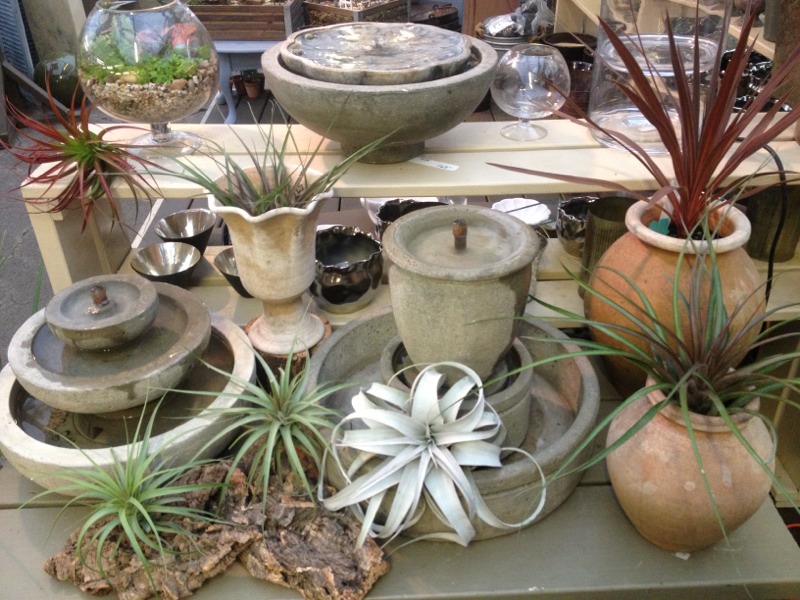
These three are cast stone, but because of their size, they’re not prohibitively heavy to move and are really lovely. The soothing, calm sound of water is so relaxing after a stressful day. Simply add a glass of wine and a book, kick back iin your favorite chair and enjoy…
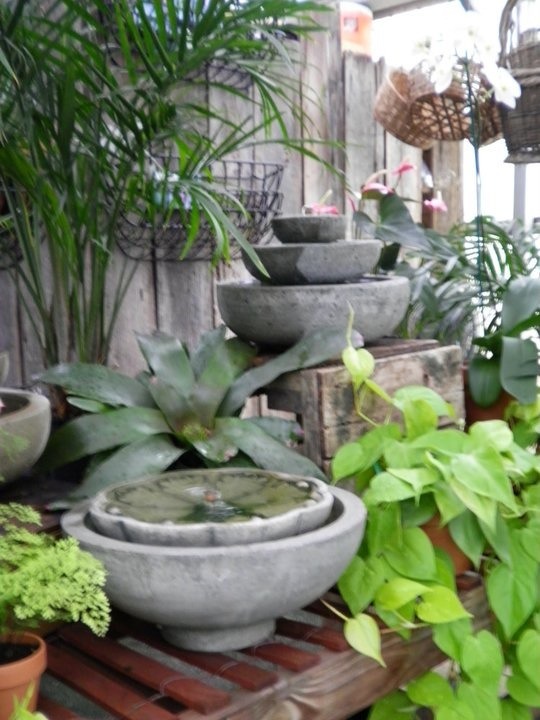
– Posted using BlogPress from my iPhone
Have We Got Some Ferns For You!
In the greenhouse, we try to always keep a good variety of ferns, and once the spring growing season is upon us we’ll also have hardy outdoor ferns as well.
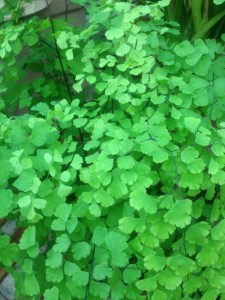
Maidenhair fern –
this is the southern
form – hardy for us
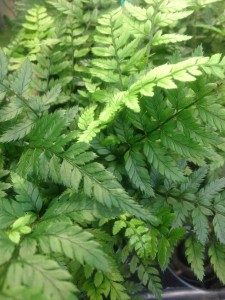
Korean rock fern is
another hardy fern
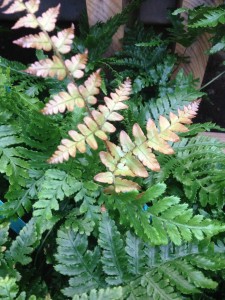
Autumn fern – hardy
AND evergreen too!
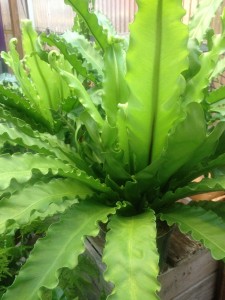
Bird’s nest fern – nothing frilly here!
Meanwhile, here is a sampling of the “houseplant” ferns we have now in the greenhouse. The selection is constantly changing , so be sure to check with us if you’re looking for something in particular. Just look at the variety of leaves here!
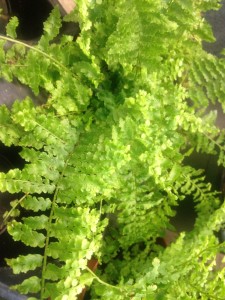
Florida ruffle –
ultra frilly!
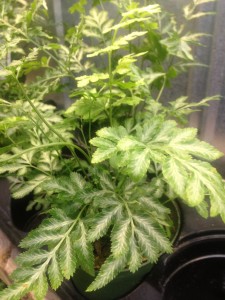
Variegated pteris
fern adds brightness
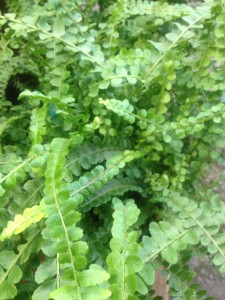
Lemon button fern adds
nice texture in mixed plantings
We use these ferns as supporting players in mixed combination shade planters as the weather warms too – the softness and color of the fern foliage contrast nicely with many shade plants including coleus, hostas, begonias, persian shield, and impatiens, just to name a few.
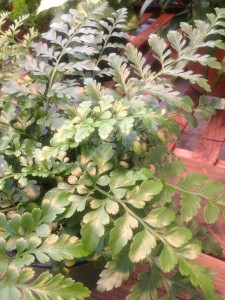
Austral gem fern
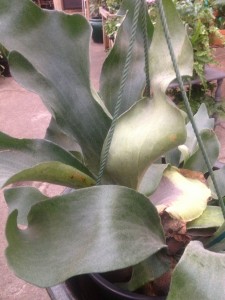
Staghorn fern
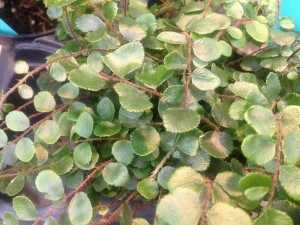
Button fern
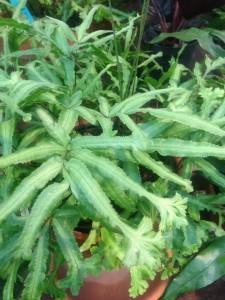
Pteris fern
In addition we’ll begin to plant custom mixes of foliage that will be wonderful for your porch or patio for the spring and summer – many will last well into the fall with adequate water and care.
Alternately, you might choose to use a grouping of pots and put one type of fern in each container. (Be sure to choose those with contrasting leaves so it’s an interesting arrangement.) Position your grouping as it pleases you for your space.
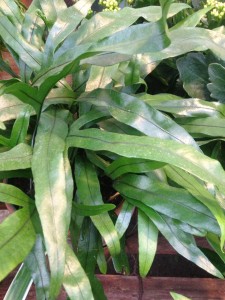
Kangaroo paw fern

Asaparagus fern – very tough and can be used in mixed planters in the sun too.
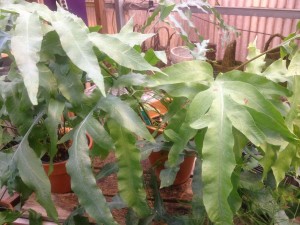
Blue Crisp Fern/Bear’s Claw Fern

